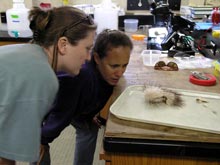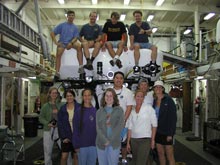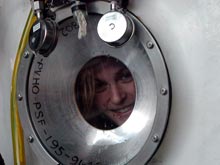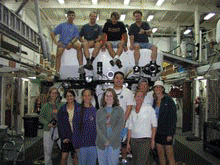
View a slideshow of images showing involvement in the "Teacher at Sea" program.
![]() Click image to view a slide show.
Click image to view a slide show.
Up From the Deep and Onto the Shore: The Deep Water Limu "Educator-at-Sea" Program
Heather Spalding
Chief Scientist and Graduate Student
University of Hawaii at Manoa
Sadie Mossman
Biology Teacher
King Kekaulike High School
Much of the research time on deep water limu (the Hawaiian word for algae, or seaweed) in Hawaii is spent on ships close to the islands. Island residents can often see the research ships from shore, but they are not able to see the beautiful limu meadows found in the deep water. A community outreach program funded by NOAA's Office of Ocean Exploration and Hawaii Undersea Research Laboratory was developed to help bring some of this research into the public eye. Two high school science teachers from Maui, a Kaho'olawe Island Reserve Commission representative, and a videographer from the Hawaiian Islands Humpback Whale National Marine Sanctuary were invited to come aboard the research vessel and participate in on-going deep water limu research. Their experiences, video, and pictures were then brought back to the classroom and the community.
Before the research cruise, graduate students participating in the research visited the participating high schools and "talked story" about the research. They described what it was like to be a scientist exploring unknown areas of the ocean floor with a submersible and discovering new species. They also described the different opportunities available to students in the field of science, from technical diving to laboratory research to being a submersible pilot. Samples of limu were brought into the classroom and examined by the students. Limu is an important part of the Hawaiian culture as a commonly eaten food item. Many of the high school students were already knowledgeable about different species of edible limu, but had never seen limu collected from deeper water or thought about the ecological significance of limu in the ocean.
Part of the science, outreach, and submersible support crew involved with deep water algae surveys. Top from left to right: Douglas Bloedorn, Steven Price, Colin Wollerman, Maximilian Cremer; bottom from left to right: Alison Sherwood, Kimberly Peyton, Cecelia Romero, Sadie Mossman, Dean Tokishi, Jennifer Smith, John Mitchell, and Heather Spalding. Click image for larger view.
A community seminar was also given in Maui about the deep water limu research. Images and on-going results from the research were presented by scientists, followed by a question and answer period. Public interest in deep water limu was keen. Invasive algal blooms are a common problem in coastal Maui, and many people inquired about the occurrence of invasive as compared to native algae in deep water. Few people were aware of the importance of calcified algae in producing sand, or the extent of deep water limu meadows in Hawaii.
Below is a first-hand account of the "Educator-at-Sea" program by high school biology teacher Sadie Mossman.
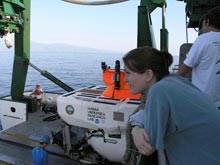
Biology teacher Sadie Mossman watches the beginning phases of the morning launch for the submersible Pisces IV.Click image for larger view.
Sadie takes a look from the submersible port hole during her tour of the inside of the submersible Pisces IV. Click image for larger view.
My Experience Aboard the KOK Research Vessel
"Educators rarely get opportunities to step out of the classroom and experience what is happening in the world of research. I was excited when graduate students Heather Spalding and Kim Peyton offered to come speak to my classes and allow me to spend a day with them as they carried out their research.
My students and I had the opportunity to see and hear about research as it was happening. My students gained an appreciation of the fact that people who do research are on a pursuit of gaining knowledge and working towards a better understanding the world around them. I gained an opportunity to see and experience the research first-hand and to learn more about the Hawaii Undersea Research Laboratory.
The people aboard the Research Vessel Ka'imikai-o-Kanaloa were wonderful. They took time out of their busy schedule to explain how everything works, and allowed us to interview them and share their wealth of knowledge. I brought my experience and many pictures back to my students as well as fellow faculty members. As I shared my experience with others, my excitement became infectious. People wanted to know more about the Hawaii Undersea Research Laboratory Program, they wanted to know more about the "skunk heart urchin," and how the research will help us gain a better understanding of limu. There were also wonderful questions being formed about how photosynthetic processes can be carried out by limu at the depths it was being found.
This program had a positive impact on me as an educator and the school community I work with. I thank all of the people who made this experience possible!"
Sign up for the Ocean Explorer E-mail Update List.







